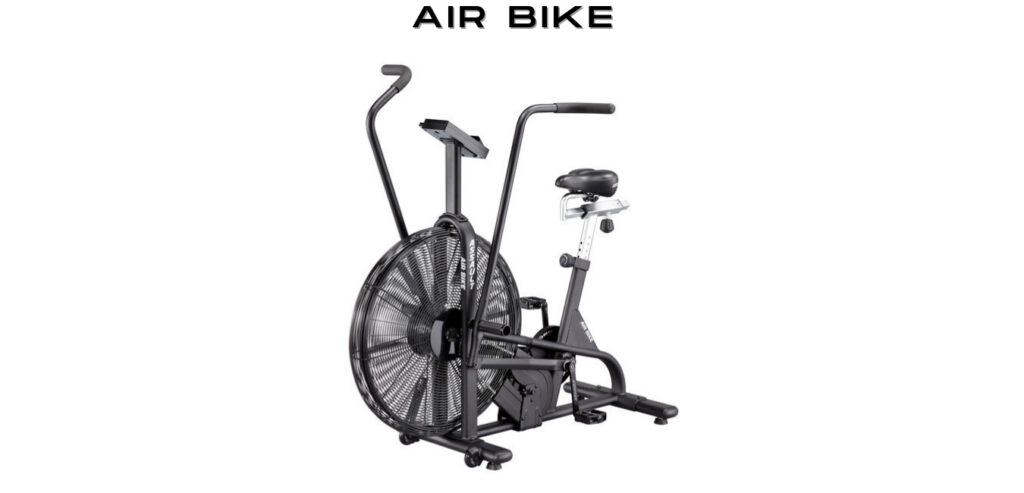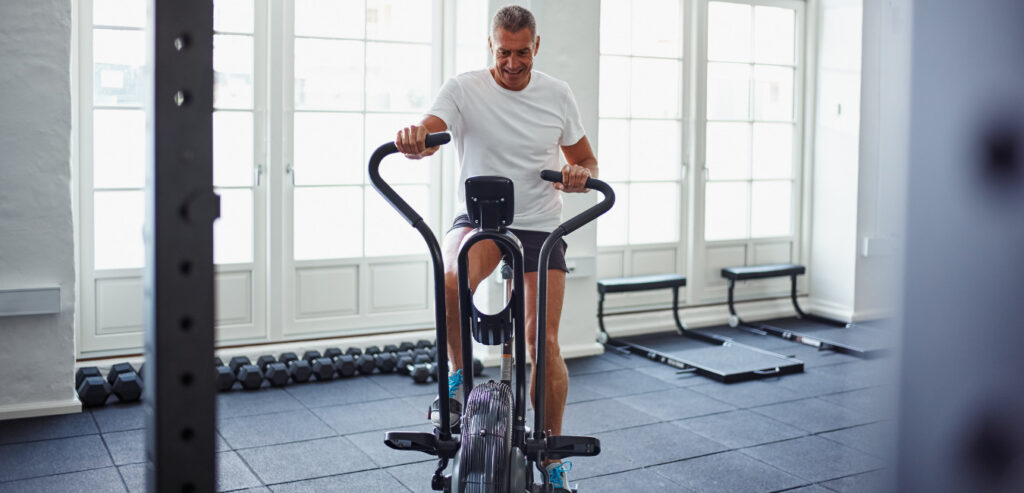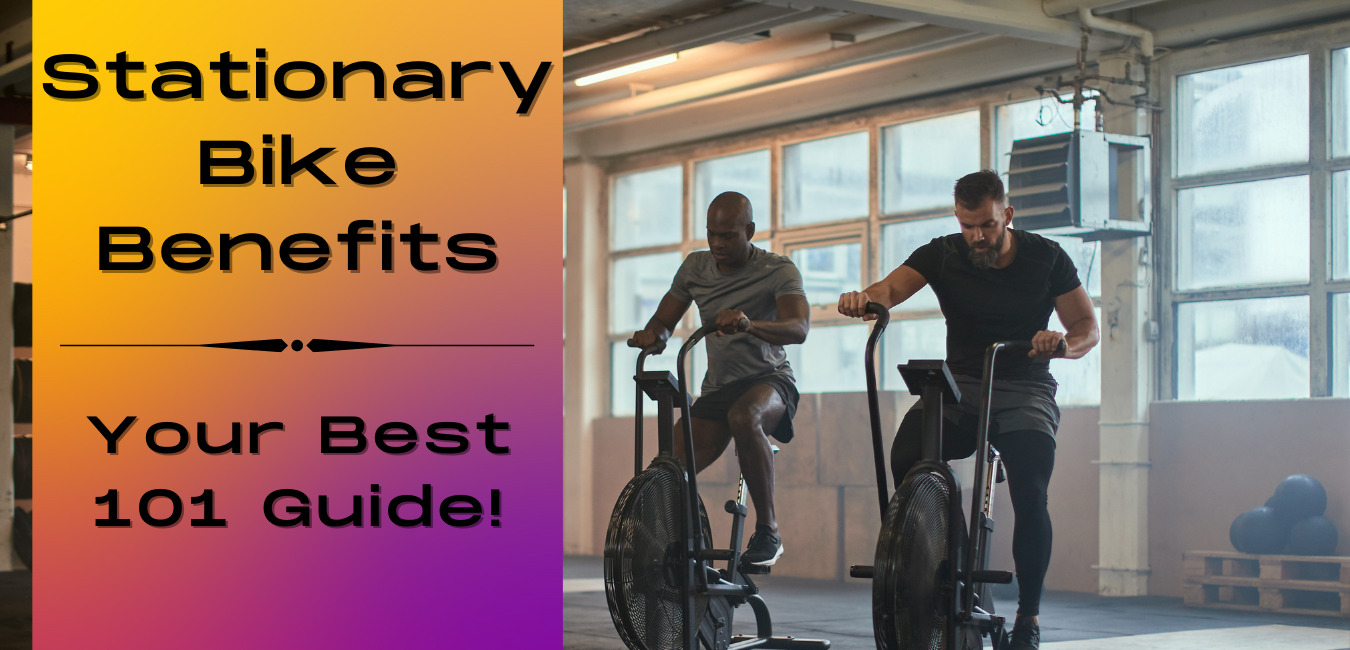The art of true living in this world is more like a wrestler’s than a dancer’s practice.
Marcus Aurelius

Stationary Bike Benefits – Your Best 101 Guide!
Stationary exercise bicycles – or simply stationary bikes – are one of the most popular ways of exercise nowadays, with multiple benefits associated with their regular use.
The stationary bike benefits are a solid argument to put your feet on the pedals though they are not the only ones.
With the lowest impact on the joints compared with similar exercise modalities – running, elliptical training, etc. – and a small footprint, stationary bikes became a staple throughout gyms worldwide, with an ever-growing number of homes relying on stationary bikes for their daily workout routines.
With that in mind, we provide you with our best 1-on-1 guide in stationary bikes. Here, you will learn about the different types of stationary bikes and how to use them safely, their benefits, and workout plans.
So, without further ado, let’s jump on the sauce by starting to see what is and which are the different types of stationary bikes.
What Is A Stationary Bike
I assume that most of you know what a stationary exercise bike is. Nevertheless, for the ones less informed, in a nutshell, a stationary bike is a piece of fitness equipment similar to a road bicycle – with pedals, a saddle, and handlebars – without wheels, used for indoor cycling.
There are three main types of stationary bikes: upright, recumbent, and dual-action. However, there are some variations that we will be covering too.
Below you will find out the different types of stationary bikes, their specificities, and their purpose.

Upright Stationary Bike
The upright exercise bicycle is arguably the most well-known model of stationary bike. It is similar to a road bicycle, meaning you can exercise while sitting or standing.
Besides your cardio, upright bicycles will work mainly on your leg muscles and core.
When directly compared with recumbent bikes, upright bikes are less expensive and have a smaller footprint, with a significant number of models available with the option of folding.
The downs of upright bikes are the relatively small saddle, which can be somehow uncomfortable in long sit workouts, and the pressure exerted on wrists and hands.

Recumbent Stationary Bike
Recumbent stationary bikes are very popular – but not only – among older people and people with physical limitations.
Unlike upright bikes, recumbent bikes have pedals in front of the saddle; therefore, the impact on your lower back and joints will reduce significantly.
The larger saddle and cushioned back will add some extra comfort to your workout, which can be a decisive factor when you decide to invest in a stationary bike.
Typically, you will feel less fatigue and soreness in the muscles since your workouts will be less intense. The latter point might be the recumbent bike’s big down if you are looking for intensive training.

Dual-Action Bike
Once upon a time, a beautiful upright bike met a charming elliptical trainer. They married and have a lovely child, and that adorable child is the dual-action bike.
Well, it was not precisely as I described, but it sums up pretty well what a dual-action bike is – an upright stationary bike with a set of handlebars similar to the ones you can find in an elliptical trainer.
The goal is to exercise your upper body while pedaling, giving you a more complete workout when compared with traditional stationary bikes.
Although the dual-action bike is the least similar to a road bicycle, if you are looking for more core and upper body muscles engagement on your stationary bike workouts, the dual-action bike might be the perfect choice for you.

Indoor Cycle Bike
Indoor cycle bikes are similar to upright bikes, though there are a few significant differences between them.
First, the indoor cycle has a seat more elevated than the upright bike, making your upper body lean forward and ultimately giving you a closer experience with a road bike.
However, the most significant difference is the way that you create resistance while working out. A weighted flywheel on the front is connected to the pedals via a belt or chain.
If you are a seasoned athlete or even a cycling enthusiast, the indoor cycle should be the most suitable option you have.

Air Bike
If you want to work your cardio to another level or have a full-body workout, the air bike is a solid option.
With a giant fan in the front, the resistance is created by your pedaling. Meaning, the more you pedal, the more resistance generate.
Air bikes have two handlebars that move – while you pedal – similar to elliptical trainers’ handlebars.
Another reason for its popularity is the price. Usually, air bikes are less expensive than the other types of stationary bikes.

Other Types of Stationary Bikes
With current technology, many are the concepts in the market involving stationary bikes though the most popular trend is the stationary bike desk.
One good reason for the stationary bike’s popularity is the diversity of models you have on the market.
There are stationary bike desks for all tastes, from upright or recumbent bikes with a desk replacing the handlebars to an under-the-desk pedal.
Although many are the claims from the improvement of one’s life when using these types of stationary bikes while working or at home, the fact is that most of the evidence available is anecdotal.
Hence, although these types of stationary bikes provide you with a workout and promote your mobility while doing other tasks, we still don’t know precisely the full benefits and disadvantages of using them.

Is Suitable for Whom
As a study on the manner attests, due to the low impact of stationary bike exercises on the body, it can be used by literally everyone, from toddlers to seniors.
“We found that older adults who had cycled recently and those who cycled for over an hour a week performed better than nonriders or infrequent cyclists on static and dynamic balance measures, which are important predictors of falls risk.
After adjusting for age, sex, and physical activity, cycling was a significant predictor of decision time and response time on a dynamic balance task.”
Compared with similar exercise modalities, stationary bikes have similar results, though the impact on the joints is lesser. Hence, stationary bike workouts offer a lower impact when directly compared with walking, stepping, running, and elliptical training, as you can see in the image below.

Although the low impact on the body, there are reasons not to exercise with a stationary bike. The most common causes are related to heart problems, blood pressure, and balance problems.
Therefore, if you think you have any limitations or doubts concerning using a stationary bike, please, consult a physician or at the very least a fitness instructor.
With that said, if you have good health and no physical injuries, you should not have reasons to worry about training with a stationary bike.

How To Use A Stationary Bike Safely
Although stationary bikes are safer than road bikes, there are still some precautions to consider when using one.
To start, you should mind your posture while working out with a stationary bicycle. A poor posture will result in a poor balance which could lead to injuries or even a fall.
If you are not sure how to position yourself correctly on a stationary bike, seek help and guidance – fitness instructor, internet, etc. – to ensure the safety of your workout.
Another point I want you to consider is the overuse of a stationary bicycle. Although stationary bikes offer you a low-impact workout, the repetitive motion of your legs – when doing in excess – could result in joint pain or muscle fatigue.
Therefore, you should listen to your body if you start to have the symptoms mentioned above and ponder taking some time off from the pedal.

Stationary Bike Benefits
Now that you are aware of the different types of stationary bikes and how to use them correctly, let’s see which are the stationary bike benefits.
Safer than road cycling
To start, the most obvious benefit of indoor cycling is safety and predictability.
I enjoy cycling outdoors, but living in the city center of Brussels can be a harrowing experience since I expose myself to all kinds of hazards.
From inattentive drivers and low visibility to poor air quality, there are many reasons to opt to exercise from the comfort of your home when you live in an urban area.
Another point is not being exposed or weather-conditioned. Rather is hot and dry or cold and rainy; none of that will influence your workout plan.
Low-impact workout
Another considerable benefit of stationary cycling is the low impact it has on the body.
For instance, stationary bikes are used in specific rehabilitation cases – knee or ankle sprain, due to the smooth impact on muscles and joints.
The impact on the body is pretty low, as you can see, even more than walking, so if you are looking for an aerobic modality with almost no impact on muscles, bones, and joints, stationary cycling might be an option to consider.
Improves your cardiovascular system
Improving your cardiovascular system has numerous benefits associated with it, which will increase your quality of life.
Cardiovascular workouts are an excellent way to put your heart pumping, which will lower your blood pressure and bad cholesterol, regulate your blood sugar, and strengthen your heart, lungs, and muscles.
Improving the oxygen flow in the body has a beneficial effect on your sleep and stress levels, among others.
Weight loss
One of the main reasons people opt for indoor cycling is weight loss, and there are plenty of good reasons for doing so.
Thirty minutes of workout can result in the loss of 200 up to 300 calories – attending the weight and workout’s intensity – while one hour of very high-intensity training can burn over 700 calories. Additionally, you will burn body fat as well.
If you have mobility issues related to weight and are looking for an efficient way – and relatively fast – to burn some calories, indoor cycling is one, if not the best option.
Reduces the risk of type 2 diabetes
Diabetes is the result of an excess of sugar in the blood, and since our muscles use glucose when we exercise, that will reduce the sugar levels in the blood.
Therefore, our body will reduce the production of insulin, which is very scarce in diabetic people. So, if you have type 2 diabetes, indoor cycling can positively impact your life.
Since each case is unique – and I am not by any means a physician – I urge you to seek professional help to create an adequate training plan attending to your specific needs and limitations.

Strengthens your heart and lungs
The heart is a muscle; hence, he will benefit from exercise like any other muscle.
A heart well-cared will reduce blood pressure since it will pump more blood at each contraction. So by doing aerobic workouts like stationary cycling, you will reduce the probability of having cardiovascular disease and strokes.
Concerning the lungs, you will not be increasing your lung capacity (i.e., the volume of air you can inspire) by doing indoor cycling.
Instead, you will be improving your ability to utilize oxygen, meaning you will require less oxygen throughout your workouts while reducing carbon dioxide production and ultimately increasing your muscle performance.
Strengthens the muscles
All types of physical activity strengthen your muscles. In the case of exercise bikes, the same happens, primarily in the lower body and legs.
Exercising with an indoor bike will positively impact your glutes, hamstrings, quadriceps, calves, core, and lower back.
Using a dual-action or air bike, you will work more actively on your upper body, namely the biceps, triceps, and shoulders.
Improves your energy levels
Riding a stationary bike – like any other sport activity – will reduce your fatigue levels while improving your levels of energy.
That happens because when you exercise, your brain releases dopamine. Dopamine is a neurotransmitter that plays several essential roles in the brain and body, some of them directly related to your body’s energy levels.
Boosts your brain function
Indoor cycling has a positive effect on your brain as well. The release of good hormones during physical activity improves your cognitive function, attention, and memory.
That results are even more evident when cycling exercise is used as therapy – chronic stroke patients, for instance – as this study shows you.
“This study aimed to test the effects of cycling exercise on the balance and gait abilities of chronic stroke patients. The results demonstrated that the stationary cycling exercise supplemented with conventional therapy led to better balance and gait abilities than the conventional therapy alone.”
Allows for interval training
Stationary bikes allow you to train at low, medium, or high intensity; therefore, indoor cycling is an excellent option for interval training.
Interval training will help you to burn more calories and increase your cardio consistently, without the everyday worries of road cycling.

Workout Plans
There are multiple workout plans adapted to all ages and fitness levels. Nevertheless, I will provide you with three generic workout plans – beginners, weight loss, and interval training – which should give you a general idea of indoor cycling workouts.
Beginners
Time: 25 up to 35 minutes
- Start at low intensity: 5 up to 10 minutes
- Switch to medium intensity: 5 minutes
Follow by:
- High intensity: 1 up to 2 minutes
- Medium intensity: 5 minutes
- High intensity: 1 up to 2 minutes
- Medium intensity: 5 minutes
- End at low intensity: 5 minutes
Weight Loss
- Start at low intensity: 5 up to 10 minutes
- Switch to medium intensity: 3 up to 5 minutes
Switch between high & medium intensity: 20 up to 30 minutes
- High intensity: 1 up to 3 minutes
- Medium intensity: 3 up to 5 minutes
- End at low intensity: 5 up to 10 minutes
Interval Training
- Start at low intensity: 10 minutes
- Switch to medium intensity: 10 minutes
Follow by:
- High intensity: 2 minutes
- Low intensity: 2 minutes
- High intensity: 2 minutes
- Low intensity: 2 minutes
- High intensity: 2 minutes
- End at low intensity: 5 up to 10 minutes
As I said before, there are plenty of other workout programs and many variations from the ones I provide you. So feel free to use and adapt them as you feel like.

My Two Cents
Throughout this article, I avoided directly comparing stationary cycling and similar exercise modalities like the treadmill or elliptical trainers since that was not the intent of this post.
With that said – and since that might be one aspect you’re researching for – I will address the elephant in the room and provide you additional information on the manner.
In a recent post about treadmill training – that you can find here – I shared some images from a study. The heart rate and oxygen consumption were compared between elliptical training, walking, cycling, stepping, and running (treadmill).
Below I’ll provide you with two images from that study to see the different results from that tests.


As you can see, the difference in results between exercise bikes and other aerobic modalities isn’t much. However – as I show you previously – indoor cycling has the least impact on the body (inclusively walking), so in the end, it is you who has to decide which modality will fit better your needs and goals.
There you have it, guys, our ultimate guide on stationary bikes. Do you think I miss something? Do you want to add something or just give me your thoughts on the subject? Don’t hesitate to drop a comment in the comment section below, and I’ll gladly reply to you back!
Before you go, if you arrived until this part of the article, I’d like to THANK YOU for your time reading another of our posts and giving us your feedback to help us improve our work continuously! It means a lot to me!
If you like our content, please consider following us everywhere (except on the street, that’s weird:)) and I’ll catch you in our next post; until then, stay strong and keep on pedaling! Amor Fati! : )
Pompeu Pedrosa,
Founder of Against the Ropes.

